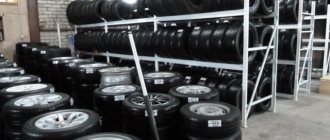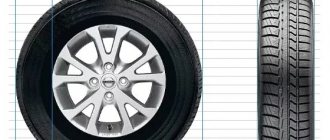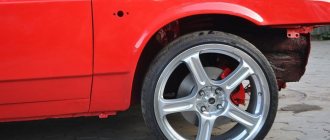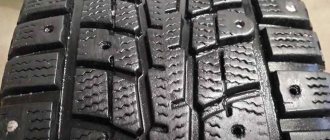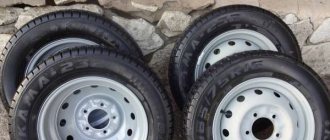Almost all car enthusiasts and professional drivers know that for road safety it is important to change tires on time, taking into account the season. However, people face a problem when storing wheels: in summer - winter, in winter - summer. And even if there is space for tires in the garage, basement or balcony, violation of storage conditions can lead to a lot of problems at the beginning of each new car season. In this article we will tell you how to properly store winter tires and summer tires with metal wheels and without rims.
What do driver mistakes lead to?
In the Russian Federation, a current manual GOST R 54266-2010 “Pneumatic tires” has been developed. Packaging, transportation and storage." The manual describes the maintenance requirements for bare tires, but they also apply to full wheels.
- The first rule is: before seasonal conservation, it is necessary to clean the outer surface of various contaminants (dust, dirt, oil products, etc.).
- The second condition is that the storage location (garage, shed, etc.) must be well ventilated and remain dry.
- The third important note is that the indoor air temperature can vary from -30 to +35, while the penetration of sunlight should be avoided, because ultraviolet radiation is the first enemy, leading to premature aging of tires.
- The fourth important point is to ensure that the rubber is at least 100 cm from any heating device.
Violation of the above rules for storing tires on or without rims often leads to negative consequences. Car enthusiasts make the following mistakes:
- They stack empty tires in a pile, and the higher it is, the more the bottom row suffers. In this case, internal curvature occurs, which is dangerous when driving - this can lead to unregulated imbalance and severe vibration of the wheel, and there is also a risk that the car will pull to the side.
- They find a hard-to-reach place where they have to squeeze the products, which leads to deformation.
- They use tires instead of a bookcase to place construction tools on them (drill, hammer drill, chainsaw, etc.).
- They are placed very close to a heat source or kept under the sun, which threatens the destruction of the product (microcracks appear, the cord peels off).
- Choose a room with a high level of humidity. This is fraught with the formation of a corrosive coating on the metal and brittleness of the rubber.
- Placed next to chemicals (alkalis and salts), gasoline, diesel fuel, solvents, paints and varnishes.
Improper storage of winter and summer wheels (tires on rims) can lead to a number of problems:
- If the seal of the seat is broken, pumping is difficult.
- Cannot be balanced.
- Due to the decrease in strength, the service life is reduced.
- Laying in a herringbone pattern leads to a non-repairable defect - a fracture of the bead ring.
Important note! If a vehicle is not used for a long time, the tires become deformed (both the inner and outer parts) and lose their perfectly round shape. Therefore, it is recommended to use loaded vehicles every three days, and partially loaded vehicles every 10 days to reduce the load on the tires.
Tire storage rules
The rubber of tires deteriorates not only during its operation, but also during storage. In order for tires to remain intact and not lose their performance characteristics, they must be stored correctly. There are a number of simple rules that, if followed, will extend the life of your tires.
- Before storing tires, they should be washed from dirt and winter chemicals, dried and treated with a preservative. If road reagents remain on the tire, they continue to negatively affect the rubber all summer, and with high humidity this process intensifies.
- Place marks on the tires (PP - right front, PZ - right rear, LP, LZ). The marks will allow you to install the wheels in the same places where they stood last season. This is especially important for winter tires with studs. It is good for a studded tire when it always spins in one direction, otherwise the studs will wobble and may fall out of the mounting location. Also, when haphazardly installing wheels on a car, at high speeds the car loses control and begins to “steer” due to uneven wear of the tires.
- You can pack tires in individual special covers. It is better not to store tires in plastic bags, since polyethylene prevents the free passage of air, and tires need to “breathe”.
The main problems that drivers face during the off-season conservation process
Of course, it is preferable to understand from the very beginning how to properly and best store tires on wheels or tires on rims. This way you will save yourself from unnecessary expenses on a new set.
Traffic safety depends on the physical and chemical properties of rubber. If you see the process of “aging”, that is, the appearance of microcracks, drying out of the material and loss of its former elasticity, then keep in mind that the use of such products will be dangerous for moving by car. A tire could burst at any moment. This defect threatens to lose control of the vehicle and get into an accident.
So, what negatively affects the quality of rubber:
- road dirt;
- residues of petroleum products;
- ultraviolet;
- excessive humidity;
- elevated temperature.
If you carefully prepare your wheels for storage, you can avoid many problems.
Features for different seasons
As for the temperature regime, not only its values and the type of tires are taken into account. The values must be maintained to be appropriate for the operating conditions of the product.
The fact is that the use of seasonal tires depends on the composition of the rubber . Therefore, it should be taken into account that summer tires are not suitable for frost, while winter tires are not suitable for heat.
Summer tires can withstand high temperatures. It must be stored in a dry place out of direct sunlight. The temperature should not be below zero degrees. You cannot keep summer tires on an uninsulated balcony. Summer tires dry out and crack in the cold.
It is not recommended to store winter tires in a warm room. They lose their elasticity when exposed to heat. This leads to a decrease in the tire's grip on the surface and causes slipping on ice. It is strictly forbidden to leave winter tires in the sun.
The general rule for winter or summer tires is the undesirable presence of heating devices closer than at a distance of 1 m. The optimal temperature for storing tires is 8 - 23 ° C.
Tires stored in improper conditions become dangerous to use. The reason is a violation of the structure of the material, rapid wear and, as a consequence, loss of operational safety.
A few excerpts from GOST
The official regulatory document provides comprehensive information on the storage of domestically produced tires. The same conditions apply to imported products. Therefore, for long-term storage, this manual applies to all vehicles. Let's look at a few rules for storing tires without or with rims.
Is it possible to leave the kit outside?
This question is asked by drivers who do not have a garage. They often use a balcony in their own apartment that is not protected from precipitation. Clause 6.10 of GOST states: in such conditions, products can only be kept for one month. Place the wheels horizontally - this will prevent deformation of the rubber, because the main load will fall on the metal. It is advisable to cover them with moisture-proof material or dark covers to prevent cracks from appearing from the sun.
Another option is to hang the products on special brackets using strong straps. And don't forget to bleed off excess air to reduce pressure.
At what temperature should tires be stored?
Paragraph 6.2 states that the optimal temperature for this is +25 degrees. Nevertheless, in the central part of the Russian Federation, conservation of domestic wheels from -30 to +35 degrees is allowed, provided that the place is dark and well ventilated.
General Tips
An excerpt from the state standard under clause 6.9 states that in order to avoid changes in the functionality of the rubber, thorough cleaning is necessary before preservation. Washing cleans the surface of various contaminants, and high pressure of water will remove small pebbles stuck in the pattern from the tread. A dried kit is easier to inspect for cracking and serious cuts.
What to avoid
Paragraphs 6.1 and 6.3 tell you how to store tires at home, in a garage or utility room. It is strictly not recommended to store wheels near the heating system (gas and electric boiler, batteries, heater) and stove. Powerful illumination and splashing from the working welding machine are unacceptable.
Rubber must be protected from contact (even short-term) with any chemicals. The list of prohibited substances includes the most common household products: gasoline, paint, solvents, paints and lubricants. If any of the above gets on the surface of the tire, the original properties of the rubber may be significantly altered.
Our production
Truck tires
Tires for special equipment
Tires for agricultural machinery
Photo tips on how to store discs
How to store grapes: how and where to properly store grapes at home (105 photos and videos)- How to make a beautiful kitchen renovation
How to store seeds - how to properly organize seed storage at home (video master class + 70 photos)
https://www.youtube.com/watch?v=oCxi6D9fk9s
Read here How to store carrots - ways to store carrots at home correctly (120 photos and videos)
Did you like the article? Share
1+
2
Choosing a place
Wheels must be stored in a closed, dry room, preferably heated. Take care of a favorable temperature inside and make sure that the sun's rays do not penetrate into the room. Preservation in the garage is considered ideal, and it is advisable to hang the products on brackets mounted on the wall, or stack them vertically on the floor. You can also arrange them in a stack.
These recommendations will help answer one of the most popular questions from motorists: how to properly store summer/winter tires on rims. And so that both types of wheels do not deteriorate for the new season, find an option that will eliminate the negative effects of ultraviolet rays and precipitation.
Tire storage methods
Depending on whether your tires are assembled with rims or not, you need to store them completely differently.
Tires without rims
Tires without rims can only be stored vertically on the tread. They can stand close together and lean on each other or on a support. But you should exclude the possibility of tires squeezing each other. If the tires are stacked lying down on top of each other, then the lower tires begin to deform and crumple under the weight of the upper ones. You can’t hang them either, as they will lose their shape under the influence of their own weight.
Complete wheels
Tires on rims can be stored in two ways: lying in a stack and hanging by the rim. Before storing the wheels, you need to check the pressure in them: it should not be too low. It is best to create a pressure of 2.2 bar.
The wheels are hung on the wall using hooks by the holes in the rims. If storing in a stack, it is ideal to place two wheels in a stack. A stack of four wheels is allowed, but no more, otherwise the rubber will be crushed and pinched. It is advisable to swap the wheels every one and a half to two months to equalize the pressure exerted by the upper wheels on the lower ones.
Regardless of what kind of tires you have and how you store them, it is better to place them not just on an earthen or concrete floor, but on wooden pallets or racks to avoid increased floor moisture, which leads to the destruction of the rubber. The air that comes into contact with the tires should preferably be the same temperature at the bottom, middle, and top of the stack so that all tires are stored under the same conditions.
Treatment of wheels with special means
After washing and drying, it is advisable to use additional protection. The best remedy is silicone grease, which can be absorbed into micropores and displaces all moisture from them. But before buying, consult with specialists and study the composition. The product should not contain chemicals that are used to restore the color of rubber (for example, solvent and others).
Manufacturing technology for a simple wheel rack
The structure must be strong to withstand the weight placed on it. And also, if it is wood, then it should be coated with antiseptics to protect against fungus, and if it is metal, then it should be painted to prevent corrosion. Most often, manufacturers make wheel racks in the garage from profiles using welding. For shelves, chipboard, thick plywood or fiberboard are used.
First, in any case, a sketch of the future product is created. All further work is based on this project, because it contains the necessary dimensions and dimensions, and it also indicates fastening points and types of fittings.
The design of the rack for wheels can be made independently Source 999.md
conclusions
The typical service life of car tires is 4-6 years with increased use. Considering that we drive a car to work every day, and off-road trips can happen on weekends, then tires can become unusable in a couple of years. To prevent this from happening and to ensure that your tires serve you for more than 5 years, it is important not only to drive carefully, avoid sudden braking and dangerous maneuvers, but also to take care of their storage.
It is best to store tires in the Attic. Our warm warehouse not only provides ideal conditions for long-term storage of rubber at any time of the year, but also provides convenient service. And let’s not forget about the benefits: the cost of storing tires without rims is 499 rubles. per month. This is an investment not only in the safety and maximum service life of car tires, but also a guarantee of your comfort - there is no need to keep it in your apartment or waste time and effort taking them to the garage. Tire storage in the Attic is a modern service for you and the right conditions for your tires. Seems like the perfect formula!
